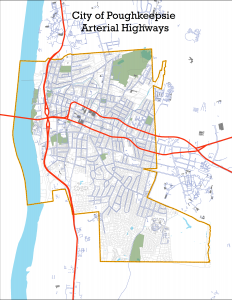Dutchess County Jail is Among the State’s Worst Offenders
Our recommendations to address mental health care and education—without cost over-runs
The New York State Commission of Corrections (SCOC) recently named the Dutchess County jail as one of the five worst in New York State (The Worst Offenders), one that “pose[d] an ongoing risk to the health and safety of staff and inmates, and, in instances, impose[d] cruel and inhumane treatment of inmates in violation of their Constitutional Rights.”
This news comes a full seven years after the Benjamin Center (then called CRREO) published its study on A Collaborative Approach to County Jailing in the Hudson Valley. We were looking for, and found, ways that counties could collaborate to control or diminish operational costs while continuing to fully assure safety and professional operation. What did we recommend?
Overcrowding and boarding inmates out at great expense were big issues. They’re being addressed so we won’t look further at them here. The jail currently operates under a variance given by the Commission that allows the use of temporary dormitory pods, pending completion of a new jail addition. Construction is still in the planning phase, with completion pushed back from 2017 to 2023.
Mental Health Services:
By circumstance, rather than design, jails have become the default local institutions that confine citizens with mental health problems. A major reason is that, as a result of changes in policy enacted over decades, many state-run mental hospitals and psychiatric facilities have been shut down or severely downsized. Jail managers in our region in 2011 reported that as much as 80% of their inmate population was being treated either for mental illness or drug and/or alcohol addiction. Currently, drug and alcohol detoxification, as well as mental health treatment for all but the worst cases, is done at the jail.
The Commission report referenced two inmate suicides since 2011. It cited the jail’s medical contractor, Correctional Medical Care (CMC), for failing to identify and act upon one suicide risk (despite a documented history of suicide attempts and signs of intoxication). In the second case, jail staff and CMC failure to identify a mental illness despite the inmate reporting a mental health history, and acting strangely at his admission. Later. a CMC staffer who followed up also failed to recognize signs of mental illness, and jail staff failed to recognize signs of acute mental illness after an incident in a hallway where the inmate could not properly follow commands.
When an inmate is assessed as at risk for suicide, either at booking or at a later time, he or she must be placed on one-on-one watch for his or her own protection. One-on-one supervision (or constant watch) means what it says: 24 hour per day supervision with one officer constantly watching one inmate. This is very costly; it’s done almost exclusively by officers on overtime. Dutchess would need a major remodel to allow a single officer to monitor two or three inmates simultaneously. This requires sight lines with no blind spots, with spaces usually designed specifically for this purpose. Once an inmate is placed on one-on-one watch, he or she cannot be taken off without the authorization of a mental health professional.
In 2011 we recommended creating an intermediary secure mental health facility in the Hudson Valley that might accept inmates in need of treatment that goes beyond what a jail might effectively provide (e.g. mandating medication), but not so extensive as to warrant sending the inmate to a specialized secure mental health facility run by the state in central New York. Such a facility could provide video psychiatric evaluations at the admissions intake of the inmate in order to determine if it is deemed appropriate to refer the inmate to the regional facility. The opportunity to seek regional solutions is diminished each time we make massive investments in another county jail.
Education:
New York State mandates that each county provides schooling for minors in jail. Worst Offenders says that Dutchess County has done an especially poor job at this.
We found that Orange County maintained an extensive education facility in its jail, and contracted with Orange County BOCES to operate a full-time school. Minors from 16-20 were mandated to attend. They were instructed in three groups defined by level of education and learning ability. Classes were held from 8-11am and 1-3:30pm. Going beyond the mandate, all inmates between the ages of 16-21 were encouraged to take vocational courses at the jail.
At any given time, the Orange County jail school enrolled 55-75 minors and 50-100 adults in its educational courses, ranging from GED and Regents high school courses to baking and podcasting. The program boasts a 97% pass rate for the GED (due to the high recidivism rate within the minor inmate population, this is a considerable number of students). Ironically, recidivism added value to the use of technology and assured some continuity in the jail’s education program. All students’ work was stored on a server so that if they left jail before the completion of their schoolwork, they could pick it up where they left off if they returned.
Implementing the collaborative regional jailing solutions we recommended for youth, women (not mentioned by the Commission) or mental health and other health services remains a heavy political lift, though it is intriguing that the state is now pushing harder than ever on counties and localities for increased collaboration, and that Dutchess has one of the strongest records in the state for its local governments working together. But even without taking such a big step, the county might get some ideas for improvement its jail operation by looking back at our 2011 study.
This is important because it was the poor screening by the medical contractor that led to the two suicides.
 Twenty years ago the City of Poughkeepsie debuted a Comprehensive Plan meant to be a road map for revitalization. If you look at Poughkeepsie today you can see, broadly, how well or poorly Poughkeepsie followed its own plan. The past 4 posts, linked in the box at right, have looked at how the city envisioned itself in 1998, and graded the implementation of the 1998 Comprehensive Plan using the metrics contained within the plan. The final tally was a failing grade of 41%.
Twenty years ago the City of Poughkeepsie debuted a Comprehensive Plan meant to be a road map for revitalization. If you look at Poughkeepsie today you can see, broadly, how well or poorly Poughkeepsie followed its own plan. The past 4 posts, linked in the box at right, have looked at how the city envisioned itself in 1998, and graded the implementation of the 1998 Comprehensive Plan using the metrics contained within the plan. The final tally was a failing grade of 41%.





